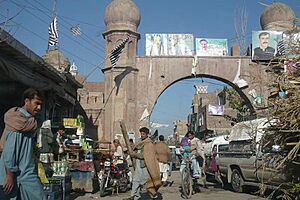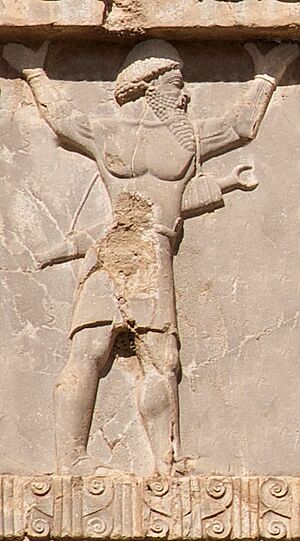Bannu facts for kids
Quick facts for kids
Bannu
|
|
|---|---|
|
City
|
|

A street in Bannu
|
|
| Nickname(s):
بنی گل
|
|
| Country | |
| Province | |
| Division | Bannu |
| District | Bannu |
| Headquarters | Bannu |
| Government | |
| • Type | Mayor-council |
| • Body | District Government |
| Area | |
| • District Bannu | 1,972 km2 (761 sq mi) |
| Elevation | 375.514 m (1,232.001 ft) |
| Population
(2023)
|
|
| • District Bannu | around 1,357,890 |
| Time zone | UTC+5 (PST) |
| Highways | |
Bannu is a city in Khyber Pakhtunkhwa, Pakistan. It is located on the Kurram River. Bannu is the main city of Bannu Division.
Most people in Bannu are from the Banuchi tribe. They speak a special kind of Pashto called Banuchi (Baniswola). This language is similar to the Waziristani dialect. People from Bannu are often called Banusi, Banuchi, or Banisi.
The city is known for making cloth and cotton fabrics. It also has sugar mills and factories that make machines. Bannu is famous for its weekly market, called the Jumma fair. The area around Bannu gets water from the Kurram and Gambila rivers.
Contents
What's in a Name?
The name Bannu has a long history. An old language called Avestan used the name Varəna. This is where the modern name comes from.
An ancient Indian grammarian, Pāṇini, wrote its name as Varṇu. Around 600 years before Christ, the area was known as Sattagydia. This name meant "country of the hundred cows."
A Look Back in Time
Bannu has been an important place for a very long time. This is because it sits on key routes. These routes, the Kurram and Tochi, lead into the Indus Valley.
Archaeologists have found old villages in the Bannu area. One of the oldest is Sheri Khan Tarakai. People lived there from about 5,000 to 2,000 BCE. Recent digs at Akra, Bannu show it was a big city. It traded with places in Central Asia during the Iron Age.
Ancient texts like the Zend Avesta mention Varəna (Bannu). They say it was one of the "16 perfect lands" created by a god named Ahura Mazda. These texts also say it was the home of a legendary king, Fereydun.
Around 600 BCE, the Bannu region was part of Sattagydia. This area was part of the Persian Achaemenid Empire. It was an important part of their empire.
Later, Alexander the Great conquered the region. After him, the Greek Seleucid Empire ruled for a short time. Then, the Mauryan Empire took control around 305 BCE. This empire ruled much of North-West India.
After the Mauryan Empire, different groups ruled Bannu. These included the Indo-Greeks, Indo-Scythian, and Indo-Parthians. The Kushan Empire later took over. They were a powerful empire in the region.
After the Kushan Empire, the Gupta Empire ruled for a while. Then, groups like the Kidarites and Hephthalites came to power. Finally, the Hindu Shahis ruled the area for over 150 years.
In the late 900s and early 1000s CE, the Ghaznavids conquered Bannu. Mahmud of Ghazni used the Bannu route for his trips into Northern India.
British Rule in Bannu
In 1848, a British officer named Herbert Benjamin Edwardes renamed the city. He also ordered a fort to be built. It was named Dhulipgarh, after the Maharajah of Lahore. The town was first called Dhulipnagar.
Later, in 1869, its name changed to Edwardesabad. In 1903, it got its current name, Bannu. The British used Bannu as a base for their military trips. These trips went into the Tochi Valley and the Waziristan area.
A military road was built from Bannu to Dera Ismail Khan. This road helped with travel and trade.
In the early 1900s, Bannu was a busy town. It had a market where many Hindu traders came. There was also a church and a high school. The British army had a base there.
The town was known for its trade in local goods. A weekly fair brought many buyers and sellers. They traded cloth, animals, wool, cotton, and grain. Bannu also had a hospital and schools.
Important Meetings
The 1947 Bannu Jirga
On June 21, 1947, a big meeting was held in Bannu. This meeting was called a jirga. Important Pashtun leaders were there. They included Bacha Khan and Dr Khan Sahib.
The jirga made a statement called the Bannu Resolution. They asked for an independent state for Pashtuns. This state would include all Pashtun areas of British India. They did not want to join India or Pakistan. However, the British government did not agree to this request.
The 2022 Pashtun National Jirga
Another important meeting, the Pashtun National Jirga, took place in Bannu. It was held from March 11 to 14, 2022. The goal was to discuss and protect the rights of the Pashtun people. Leaders talked about problems faced by Pashtuns. They tried to find solutions for these issues.
Geography and Weather
Climate of Bannu
Bannu has a hot, dry climate. Summers are extremely hot, and winters are mild. The average yearly temperature is about 24.8 degrees Celsius (76.6 degrees Fahrenheit).
June is the hottest month, with highs around 42.2 degrees Celsius (108.0 degrees Fahrenheit). January is the coolest, with lows around 5.9 degrees Celsius (42.6 degrees Fahrenheit). Bannu gets about 311.8 mm (12.28 inches) of rain each year. Most of this rain falls during the monsoon season, from July to September.
| Climate data for Bannu | |||||||||||||
|---|---|---|---|---|---|---|---|---|---|---|---|---|---|
| Month | Jan | Feb | Mar | Apr | May | Jun | Jul | Aug | Sep | Oct | Nov | Dec | Year |
| Mean daily maximum °C (°F) | 17.5 (63.5) |
20.0 (68.0) |
25.5 (77.9) |
32.5 (90.5) |
39.3 (102.7) |
41.5 (106.7) |
37.5 (99.5) |
36.0 (96.8) |
35.0 (95.0) |
31.0 (87.8) |
24.5 (76.1) |
18.5 (65.3) |
29.9 (85.8) |
| Daily mean °C (°F) | 10.0 (50.0) |
12.2 (54.0) |
17.0 (62.6) |
23.8 (74.8) |
30.6 (87.1) |
34.8 (94.6) |
32.6 (90.7) |
31.2 (88.2) |
28.6 (83.5) |
22.3 (72.1) |
14.9 (58.8) |
9.8 (49.6) |
22.3 (72.2) |
| Mean daily minimum °C (°F) | 2.5 (36.5) |
4.5 (40.1) |
8.5 (47.3) |
15.0 (59.0) |
22.0 (71.6) |
27.5 (81.5) |
25.5 (77.9) |
24.5 (76.1) |
19.5 (67.1) |
12.0 (53.6) |
5.5 (41.9) |
2.0 (35.6) |
14.1 (57.4) |
| Average precipitation mm (inches) | 45 (1.8) |
50 (2.0) |
60 (2.4) |
20 (0.8) |
10 (0.4) |
10 (0.4) |
95 (3.7) |
85 (3.3) |
15 (0.6) |
5 (0.2) |
10 (0.4) |
30 (1.2) |
435 (17.2) |
| Source 1: Climate-Data.org | |||||||||||||
| Source 2: World Weather Online | |||||||||||||
People of Bannu
Population Growth
| Historical Population | ||
|---|---|---|
| Year | Pop. | ±% p.a. |
| 1951 | 27,199 | — |
| 1961 | 31,623 | +1.52% |
| 1972 | 43,757 | +3.00% |
| 1981 | 43,210 | −0.14% |
| 1998 | 47,676 | +0.58% |
| 2017 | 49,965 | +0.25% |
The population of Bannu city has grown over the years. In 1951, there were about 27,199 people. By 2017, the population had increased to 49,965.
Main Tribes
Many different tribes live in Bannu. The main ones are the Banusi and Wazir tribes. Other tribes include:
- Banusi (Shitak)
- Khojak (suleman khel)
- Wazir
- Sayyed
- Awan
- Bangash
- Yousafzai (Mughal Khel)
- Khattak
- Marwat
Learning and Education
Bannu has many schools and colleges. The first public university, University of Science and Technology, Bannu, opened in 2005. There is also a medical college, Bannu Medical College. A campus of the University of Engineering and Technology, Peshawar is also in Bannu.
The oldest and most famous college is Government Post-Graduate College Bannu. It started in 1951. Here are some other important schools and colleges:
- University of Science and Technology, Bannu
- Sarhad University Bannu Campus
- Kalam Bibi International Women Institute
- Bannu Medical College
- Government College of Nursing Bannu
- Akram Khan Durrani School and College
- Bannu Law College
- Government College of Management Sciences, Bannu
- FG Degree College for Women, Bannu Cantt
- Bannu Degree College No.1
- Bannu Polytechnic Institute
- Army Public School and College, Bannu
- Government Degree College No.2
- Government Post-Graduate College Bannu
- University of Engineering and Technology Peshawar, Bannu Campus
Famous People from Bannu
Many talented people come from Bannu. They are known in sports, politics, and other fields.
- Murad Jehan: An international volleyball player and captain of Pakistan's team.
- Zahid Akram Durrani: Deputy Speaker of the National Assembly of Pakistan.
- Peter Gracey (1921–2006): An English cricketer.
- Abdul Hamid (field hockey): A former Olympian and Secretary General of Pakistan Hockey Federation.
- Abdul Rashid (field hockey, born 1947): Another former Olympian.
- Ghulam Ishaq Khan: A former President of Pakistan.
- Maria Toorpakai: An international female squash player.
- Qazi Mohib: A former Olympian and captain of Pakistan Hockey Team.
- Akram Khan Durrani: A former Chief Minister of Khyber Pakhtunkhwa.
- Dr. Qibla Ayaz: Chairman of the Council of Islamic Ideology.
- Harbans Kapoor: A former member of the Uttarakhand Legislative Assembly.
- Shah Muhammad Wazir: A member of the Khyber Pakhtunkhwa Assembly.
- Subhan Qureshi: A biologist and founder of Dairy Science Park.
- Ayesha Gulalai Wazir: A former member of the National Assembly of Pakistan.
- Dost Muhammad Khan: A former Chief Justice of the Supreme Court of Pakistan.
- Zakir Khan: A cricketer.
- Nasir Iqbal: An international squash player.
- Khushdil Shah: An international cricket player.
- Sadia Gul: An international female squash player.
- Zartaj Gul Wazir: A former Minister of Climate Change of Pakistan.
- Ghazi Sial: A famous poet and writer of Pashto folk songs.
- Jaman Lal Sharma: A former Indian field hockey player.
Images for kids
See also
 In Spanish: Bannu para niños
In Spanish: Bannu para niños






